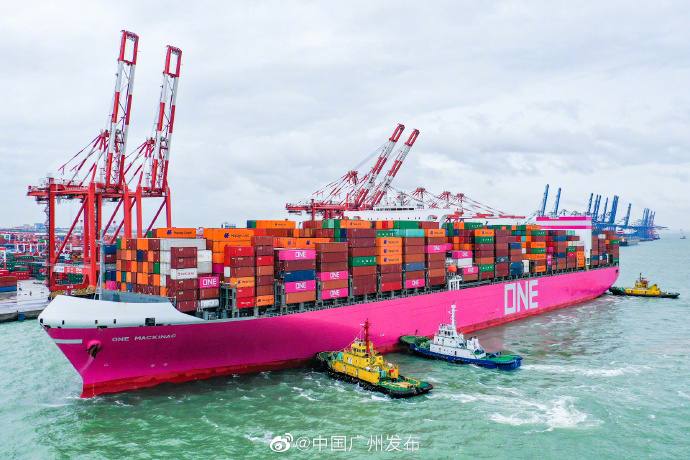- Joined
- Jan 17, 2010
- Messages
- 7,443
- Reaction score
- 9,338
Lori Ann LaRocco
@LORIANNLAROCCO

A perfect storm in global trade is creating a shipping container capacity crunch, fueling a sudden and surprise spike in ocean freight rates.
The beginning of peak shipping season, coupled with the longer transits to avoid the Red Sea, and bad weather in Asia, have hit the flow of trade on key routes. Ocean carriers are skipping ports or decreasing their time at port, and not picking up empty containers, in an effort to keep vessels on track for delivery.
The supply chain cost issues come at a time when consumer goods for back to school and the holidays are set to be moved on the water.

“From the Far East into the U.S. West Coast, it is likely spot rates will surpass the level seen at the height of the Red Sea crisis earlier this year, which demonstrates how dramatic the recent increases have been,” said Emily Stausbøll, senior shipping analyst at Xeneta.
Xeneta ocean freight rates show the rallying spot market and the widening spread between spot and long-term rates. “The bigger the spread between long and short term rates, the greater the risk of cargo being rolled, which we know is already happening,” she said.
Spot rates had fallen after the sharp rise triggered by Red Sea tensions in early 2024, but since the end of April they began spiking by as much as $1,500, on average, on routes to the U.S. coasts, and now some of the highest contract rates charged by shippers are over double the rates of just a month ago.
Stausbøll said this will bring back memories of the chaos caused by lack of available capacity during the Covid-19 pandemic. “Similarly to back then, some freight forwarders are now being pushed to premium rates to secure space guarantees,” she said.
Early Xeneta data suggests rates will increase further at the start of June.
DHL has been warning about about a container crunch since January because of the longer routes needed to avoid the Red Sea since the Houthi attacks began. Containers are out on the water longer and as a result not available to be reloaded. The availability of containers has been slowed even further by the bad weather impacting port operations in China, Malaysia, and Singapore.

He cited a shortage of 40-foot containers at the Chinese port of Chongqing last week. “As high demand and longer transit times continue, we are closely monitoring the situation to address any potential challenges,” Alebrand said.

Judah Levine, Freightos’ head of research, says that in March and April, ocean carriers were able to use idle vessels as well as ships from other lanes to help offset the longer voyages, keep containers moving and for the most part keep to weekly departure schedules. “But this has meant there is no excess capacity in the market,” he said.
Bad weather in East Asia at the end of April created some further delays, which was one factor leading ocean carriers to skip some port calls or shorten their turnaround at destination ports to make up time. That also means fewer empty containers have been brought back to China.
An increase in ocean freight rejections shows the imbalance.
“The recent increase in demand for exports out of China, together with the dip in the number of repatriated empty containers, means shippers are starting to find empty equipment hard to come by at some export hubs,” Levine said. “Even though demand levels are not extremely high, with vessel capacity already stretched thin, the recent increase in demand is enough to push rates up, and the added lack of containers is only helping to push them up even higher.”

Logistics price increases are ultimately passed onto the consumer and the dizzying freight rates during the pandemic were among factors cited by the Federal Reserve as a cause of inflation. In a series of customer alerts, logistics providers are warning shippers around the world, such as major retailers, of the container shortage.
“Carriers are facing serious equipment shortage nowadays due to the long-term congestion, blank sailings, demand increase caused by South America tariff implementation and so on,” warned Orient Star Group in a note to clients. “Plenty of shipments are delayed by EQ [equipment] shortage which lead to heavy backlogs, and as a result, space shall get much tighter in the market. We’re trying our best to encourage the shippers to arrange empty container pick up as early as possible to occupy the resource well in advance.”

@LORIANNLAROCCO
- An ocean container capacity crunch has hit global trade just as peak shipping season starts, with freight spot rates up some 30% over the past few weeks and heading higher.
- Bad weather, longer ocean transits, and vessels skipping ports are adding to the supply chain issues.
- Freight intelligence firm Xeneta is warning that rates could rise through June, and the “dramatic” rise will surpass the Red Sea spike, ultimately hitting consumer prices.

A perfect storm in global trade is creating a shipping container capacity crunch, fueling a sudden and surprise spike in ocean freight rates.
The beginning of peak shipping season, coupled with the longer transits to avoid the Red Sea, and bad weather in Asia, have hit the flow of trade on key routes. Ocean carriers are skipping ports or decreasing their time at port, and not picking up empty containers, in an effort to keep vessels on track for delivery.
The supply chain cost issues come at a time when consumer goods for back to school and the holidays are set to be moved on the water.

“From the Far East into the U.S. West Coast, it is likely spot rates will surpass the level seen at the height of the Red Sea crisis earlier this year, which demonstrates how dramatic the recent increases have been,” said Emily Stausbøll, senior shipping analyst at Xeneta.
Xeneta ocean freight rates show the rallying spot market and the widening spread between spot and long-term rates. “The bigger the spread between long and short term rates, the greater the risk of cargo being rolled, which we know is already happening,” she said.
Spot rates had fallen after the sharp rise triggered by Red Sea tensions in early 2024, but since the end of April they began spiking by as much as $1,500, on average, on routes to the U.S. coasts, and now some of the highest contract rates charged by shippers are over double the rates of just a month ago.
Stausbøll said this will bring back memories of the chaos caused by lack of available capacity during the Covid-19 pandemic. “Similarly to back then, some freight forwarders are now being pushed to premium rates to secure space guarantees,” she said.
Early Xeneta data suggests rates will increase further at the start of June.
DHL has been warning about about a container crunch since January because of the longer routes needed to avoid the Red Sea since the Houthi attacks began. Containers are out on the water longer and as a result not available to be reloaded. The availability of containers has been slowed even further by the bad weather impacting port operations in China, Malaysia, and Singapore.

Shipping capacity forecasts were off
Many logistics experts had forecast sufficient container and vessel capacity after a global freight recession to handle the supply chain issues, from the Red Sea to a drought-ridden Panama Canal. But Goetz Alebrand, head of Ocean Freight Americas for DHL Global Forwarding, tells CNBC that vessel space on many trade lanes is insufficient to meet market demand. “Trade lanes from Asia to Latin America, Transpacific routes, and Asia to Europe are all experiencing space constraints,” said Alebrand. “These shortages are affecting specific locations, some carriers, and certain types of equipment.”He cited a shortage of 40-foot containers at the Chinese port of Chongqing last week. “As high demand and longer transit times continue, we are closely monitoring the situation to address any potential challenges,” Alebrand said.

Judah Levine, Freightos’ head of research, says that in March and April, ocean carriers were able to use idle vessels as well as ships from other lanes to help offset the longer voyages, keep containers moving and for the most part keep to weekly departure schedules. “But this has meant there is no excess capacity in the market,” he said.
Bad weather in East Asia at the end of April created some further delays, which was one factor leading ocean carriers to skip some port calls or shorten their turnaround at destination ports to make up time. That also means fewer empty containers have been brought back to China.
An increase in ocean freight rejections shows the imbalance.
“The recent increase in demand for exports out of China, together with the dip in the number of repatriated empty containers, means shippers are starting to find empty equipment hard to come by at some export hubs,” Levine said. “Even though demand levels are not extremely high, with vessel capacity already stretched thin, the recent increase in demand is enough to push rates up, and the added lack of containers is only helping to push them up even higher.”

Fear of new post-pandemic supply-chain cost record
This latest round of soaring ocean freight rates comes after a previous high earlier in the year during which an “elevator floor” characterized by Levine of $3,000-$5,000 a container was set. At that time, prices compared to a year ago were double.Logistics price increases are ultimately passed onto the consumer and the dizzying freight rates during the pandemic were among factors cited by the Federal Reserve as a cause of inflation. In a series of customer alerts, logistics providers are warning shippers around the world, such as major retailers, of the container shortage.
“Carriers are facing serious equipment shortage nowadays due to the long-term congestion, blank sailings, demand increase caused by South America tariff implementation and so on,” warned Orient Star Group in a note to clients. “Plenty of shipments are delayed by EQ [equipment] shortage which lead to heavy backlogs, and as a result, space shall get much tighter in the market. We’re trying our best to encourage the shippers to arrange empty container pick up as early as possible to occupy the resource well in advance.”






